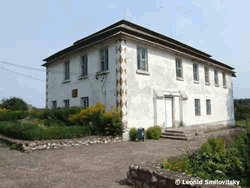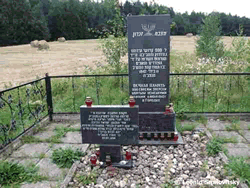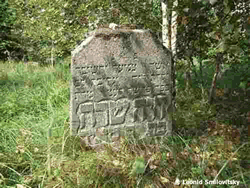http://thepointjournal.com/output/index.php?art_id=257&spr_change=eng
by Leonid Smilovitsky
I visit Belarus almost every year. It is connected with topics of my scholarly interests. I was born here, educated, married, begot my first son, and began my scholarly career. It all seems familiar, yet changes are obvious. Every time I visit, I find something new, inimitable, and specific only to this country with its orders, national character, and attitude to the surrounding world.
Now I want to narrate about Haradok (Russian: Gorodok, Polish: Gródek) where – like in a drop of water – the fate of Belarusian Jews has been reflected. Before the Second World War this ethnic group constituted one million people, or 10% of the Belarus’ population.
Haradok is the former small town in the Vileika district of the Vilna Gubernia; now it is a village in the Maladzie?na district of the Minsk Region. I am travelling to my acquaintances Tatsiana and Aliaksandr Smolik. Tatsiana is the director of the local museum; she is planning to open a Jewish exposition. And she is not alone in her initiative. Lately the Jewish history of Belarus has been eliciting increasing interest. This is encouraging. There appeared a significant group of non-Jewish enthusiasts. In Navahrudak – it is Tamara Viarshytskaya, in Dziatlava – Zhanna Nahavonskaya, in Asipovi?y – Neanila Tsyhanok, in Smilavi?y – Ludmila Drapeza, in ?ervie? - Iryna Vabishchevich. Ina Sorkina described in detail the Jewish life of Svisla? and Kapyl, Volha Sabaleuskaya – that of Hrodna, Zachar Šybieka – of Minsk, and others.
Haradok has its "namesakes" – former small towns, and now villages of the Klimavi?y and Minsk districts, the district center Haradok in the Viciebsk Region. Then there are "relatives" Davyd-Haradok (Brest Region), Kažan-Haradok (Luniniec district), Asinaharadok (Pastavy district), Astrašycki Haradok and Siomka? Haradok (Minsk district). There are also derivatives from the same root — Haradcevi?y (near Liepiel’), Haradziaci?y (near Liuba?), Haroža (near Asipovi?y). The etymology of the place name is beyond the doubt. The name Haradok means a small town, fortification, center of trade and crafts with a considerable proportion of the population not involved in agricultural activities.
Jewish small towns with the same name exist not only in Belarus. Ukraine has its own "Horodoks" (Russian: Gorodok, Polish: Gródek). For instance the village Horodok in the Manievychi district of the Volhynia Region, Horodok as a district center in the L'viv Region, and a district center named exactly the same in the Khmelnyckyi Region. In English the name Haradok is translated as small town. Similar small towns, inhabited by Jews (miaste?ki) existed in most European countries: Kleinstädte, Flecken or Marktflecken in Germany, m?stys in Bohemia, commune in France, piccola città or commune in Italy.
The first written reference to "our" Haradok dates from 1162. In different time periods the town belonged to different clans of magnates, including the Hlebowiczs, Halinskis, Karnickis, Chmaras, Tyskiewiczs.
As a result of the Second partition of the Polish-Lithuanian Commonwealth (1793) Haradok found itself in the Russian empire. From the end of the 19th century until the 1940s the majority of the town’s population consisted of Jews. In the year 1847, 496 Jews lived in the town, in 1897 — 1230 (76.6%), in 1921 — 990.
The town lived a full-scale religious life. In the center of Haradok the Jews built a two-storied stone synagogue. In 1839-1853 its rabbi was Eliyahu Chaim Meisel. As a matter of fact, the synagogue was built on the same lot as the Orthodox and Roman Catholic churches. The building of the synagogue remained intact; although now it serves as the seat of the unitary agricultural enterprise "Biarezina-Ahrapradukt".
In the second half of the 19th century Haradok housed the following: the community administration, two Orthodox churches, two synagogues, a brewery, 22 shops, three taverns, an inn, a public school, a water-driven mill, a brick factory, a textile factory, a copper processing plant. In the beginning of the 20th century there appeared two Jewish religious schools, three tanneries, three plants manufacturing dishes, a plant producing mineral and carbonated water. The number of Jewish shops (there were no others) grew to 25, that of taverns — to 12. There was a Jewish savings and loan association, active branches of Jewish political parties. Some Jews sympathized with Zionists, others with the Bund (the General Jewish Labor Bund of Lithuania, Poland and Russia).
Prominent inhabitants of Haradok included Baruch Ruderman (1865-1928), one of the founders of the Jewish socialist movement in England, the rabbi Ezekiel Sarna (1889-1969), the writer Chaim-Avrom Friedland (1891-1939), the poet Zelik M. Akselrod (1904 -1941), brother of the noted artist Meer Akselrod (1902-1970).
Émigrés from Haradok dispersed throughout the world, and were successful in many fields, due to their erudition. Chaim-Avrom Friedland, after receiving the traditional Jewish education, migrated to the United States. There, after graduating from the pedagogy department of the Columbia University, he established in New York in 1910 the first school for women with Hebrew language of instruction. After 1920 Friedland has lived in Cleveland, Ohio, where he published poetry and short stories, articles on problems of culture and pedagogy.
The fate of Ezekiel Sarna was rather curious. During the World War I he was evacuated from Slobodka to Kremenchug, where he became a student of the noted Jewish sage Chofetz Chaim. In 1924 Sarna departed for Palestine, and settled in Hebron; in 1927 he was heading the yeshiva "Hebron". He also renewed the yeshiva in Jerusalem, demolished by Arabs. Later Sarna became a member of the Council of Torah Sages (leading organ of the party "Agudat Yisrael"), and author of many works in the fields of Hebrew philosophy and religious legislature.
In accordance with the Riga peace treaty of 1921, Haradok was alotted to Poland; then, in 1939, it joined the Belarusian Soviet Socialist Republic (BSSR). In the beginning of the Soviet-German war, Jews of Haradok were doomed to death. In March of 1942 the occupiers created a ghetto with capacity of about 1500. At the end of May 1942 about a hundred young Jews were deported to a labor camp in Krasnaje. On November 11 the ghetto was destroyed. Altogether 900 Jews perished (720 from Haradok, and 180 from surrounding villages). A black granite monument with inscriptions in Russian and Hebrew testifies to this tragedy.
The memory of Haradok’s Jewish life has moved to the cemetery. I am asking Tatsiana Smolik to lead me there. One can get there only through a private courtyard — brushwood and wind-fallen trees make access difficult. Ahead there is a ploughed field, then a low stone pale, or whatever remained of it. Finally, I notice matzevot (gravestones). There are many; it doesn’t make sense counting them. Most of them are now covered with grass and greensward, grown over by brushwood. The cemetery is large; in my estimate, it has over one hundred graves. This is what is still noticeable on the surface. I am reading inscriptions in Hebrew....
I walk the streets and wonder. One may still distinguish the features of a Jewish construction site, the pavement laid out in stones. Haradok has an orderly appearance; houses are looked after, there are flowers in the yards... Is this a dying village? Tatsiana Smolik relates that lately Haradok has experienced a second wind. Altogether 600 inhabitants have remained; from this only 400 are locals. The rest have arrived. In general, they are matured children, who have not let their parents' "heritage" become desolate. The renovated houses are transformed into places of rest. Livestock is not kept, greenhouses are not built; there are practically no gardens (not profitable). There are only orchards, small meadows and flowerbeds. This produces the tidy appearance. What’s interesting, as far their ethnic composition is concerned, inhabitants of today's Haradok are Belarusians and descendants of Jews.
Haradok’s last Jew is buried... in an Orthodox cemetery. It's a strange story. I am asking to show his grave. And really, midst crosses and metallic pales there rises a modest gravestone, on which I read: Yankel Iosifovich Averbukh (1891 - 1969). No, he was no baptized Jew; the baptized usually changed their names.
How did this happen? The Nazis came to Haradok on the second or third day of the war. Nobody had time to be evacuated. After the republic’s liberation only Averbukh returned to his native hearth; in 1939 the NKVD deported him as a “bourgeois” and a Jewish nationalist. When Yankel died at 78 years of age, his Orthodox neighbors buried him in their own cemetery; there was no Jewish cemetery anymore, and nobody knew the customs.
I ask Tatsiana whether anyone is interested in the traces of Jewish life of Haradok? Local authorities are not, as there is constant lack of budget funds. Several times relatives of Haradok’s Jews from the United States and Israel visited the town, there was also a group of students with a teacher from Poland. And Belarusians? Pundits - no, but enthusiasts - yes. How did it start? In 2011 Tatsiana Smolik, who was appointed as a director of the museum in Haradok, called Kuzma Kazak from the History Workshop in Minsk and asked for help. Thus the project "Friends of Haradok" was launched on September 12, 2012 with the aim to restore, preserve and develop the historical and cultural heritage. The project’s purposes are maintenance of a scientific basis and the reconstruction of the historical past of the former Jewish town, the formation of the historical and cultural center “Haradok”, and its inclusion into tourist destinations and eco-tourism program.
I also promised to help. On parting, Tatsiana gave me hamsa (a palm-shaped protective amulet, “the hand of God”) with the words “Greetings from Belarus 2013”.
It happened that I was writing these my impressions of Haradok on the eve of the Jewish year 5774 in Jerusalem. I interrupted this process and went to my synagogue. It is known that on the day of Rosh Hashanah, or the Day of Judgment, God judges the world and people. All the prayers are intended to influence the decision of the Creator. According to belief, prayer and repentance of own sins are to help achieve a better fate for a person himself/herself and his/her family. I was listening to the shofar (a wind musical instrument made from a ram's horn), and behold the images of the Haradok's Jews, once a large and thriving community forever gone into oblivion. The same persons and images, the same words and prayer addressed to the Almighty God, just a different epoch and time.
Author: Dr. Leonid Smilovitsky, chief researcher, The Goldstein-Goren Diaspora Research Center, Tel Aviv University.
This article appeared in Belarusian Review, Vol. 25, No. 3.



